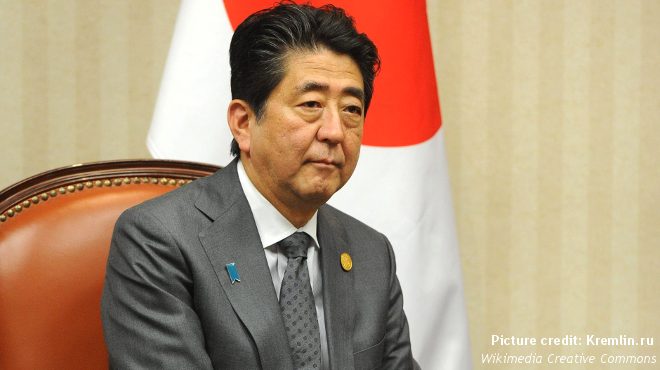Abe Pushing the Reset Button – and Positioning Himself for Next Year?

On August 3, Japanese Prime Minister Shinzō Abe reshuffled his Cabinet for the third time since winning reelection in 2014. The changes came after a series of scandals this year which have damaged approval ratings and culminated in a landslide election loss in Tokyo. 14 out of 20 ministers are new, and key positions to national security like the Minister of Foreign Affairs and the Minister of Defense have changed. Although the reshuffle will affect domestic politics and foreign relations the more interesting shifts will involve the upcoming potential leadership election rivals to Abe, as well as the balance of power between the government and the LDP.
New and Old Faces After the Reshuffle
When it comes to domestic politics, Abe’s primary goal with the reshuffle was to stabilize the government and rebuild public support, by appointing a “results-oriented cabinet of diligent people” (kekka honi no shigotojin naikaku). Just a few months ago the government’s approval ratings were solid. Now, in the wake of the Moritomo Gakuen and Kake Gakuen scandals, and the ‘memo scandal’ in which the former defense minister Tomomi Inada was accused of covering up a memo from Japanese peacekeepers, support has dropped significantly.
The installment of Itsunori Onodera back into his old position as Defense Minister signals a will to reinstate confidence in the leadership of the ministry, which according to the Mainichi Shimbun’s sources was damaged during Inada’s tenure. The Sankei Shimbun writes that positive appraisals of Onodera are already coming from ministry officials, who describe him as someone who understands the heavy responsibility of the office toward the Japanese people and the Self-Defense Forces. On relations with Japan’s Asian neighbors, Onodera seems less likely to cause trouble than his predecessor.
Fumio Kishida has been the Foreign Minister since Abe’s LDP was elected in 2012. He has now left that position to assume an important party post of chairman of the LDP’s Policy Research Council. Kishida, who is also the leader of the middle-of-the-road internal LDP faction Kōchikai, was seen as one of the core members of Abe’s Cabinet alongside the Deputy Prime Minister and Minister of Finance Tarō Asō and Chief Cabinet Secretary Yoshihide Suga. The latter two are among the only six members that stayed on through August 3.
The new Foreign Minister, Tarō Kōno belongs to Tarō Asō’s Shikōkai faction , which is more hawkish than Kōchikai. However, Kōno’s own political positioning is fairly middle-ground, and it appears unlikely that the new cabinet would herald a more confrontational attitude toward Japan’s neighbors – quite the contrary.
LDP Factionalism and Post-Abe
In a similar way to Onodera, Tarō Kōno should also be seen as a safe choice. However it is unclear if Abe actually wanted this change. The Yomiuri Shimbun has reported that Kishida’s move from the foreign ministry to one of the “three high posts” (tō sanyaku) of the LDP was in accordance with his own wishes. This shift can be seen as part of an effort by Kishida to further bolster his experience ahead of the LDP leadership struggle that will ensue “post-Abe”. With his elevation to Foreign Minister, not only his predecessor but Kōno himself is also considered to be a potential future leader of the LDP.
Since the reshuffle, Kishida’s Kōchikai faction now boasts the largest number of Cabinet members: four. If this is any kind of indication, Kishida seems well-positioned to be the next LDP leader. Whether this happens already next year in a challenge to the incumbent Abe, or when he is the outgoing leader in his last term three years later might depend on how the polls develop – if they remain low, internal momentum to oust Abe might build. If they improve, his position will be less threatened. In a Kyodo telephone poll on August 3 and 4, the Cabinet support rate rose to 44,4 percent, up 8,6 percentage points since July.
The situation is much clearer for Internal Affairs Minister, Seiko Noda, the only candidate who has publicly declared her intention to run in the next leadership election. She has been critical of Abe in the past, and tried to challenge him in the previous leadership contest in 2015. That time around she did not have enough support from the party to run, but she has declared now that she is “definitely running” next year. As the domestic popularization of the term “Womenomics” and the existence of a Cabinet minister specifically in charge of “Female Empowerment” – incidentally Noda – shows, there is great interest in elevating female candidates to the higher echelons of power in Japan. As an LDP leader Noda would change the political calculus for Tokyo governor Yuriko Koike, who is seen as a future potential first female Prime Minister.
Abe Ikkyō and Relations with the Party
The elevation by Abe of potential rivals to key positions can be seen as counterintuitive – why give your opponents a platform to build their power? It is likely that doing this was seen as a necessary evil. Low approval ratings and criticism within the party that it was too reliant on one person and his closest allies made in necessary to create a cabinet more inclusive of the LDP’s different factions. It is also possible that Abe wanted to create a situation with many potential contestants, rather than have the “anti-Abe” forces eventually coalesce around one candidate down the road. Divide and conquer might be the Prime Minister’s recipe for continuing the so called Abe ikkyō, or Abe Dominance, through the party leadership election in September 2018 and the next general election.